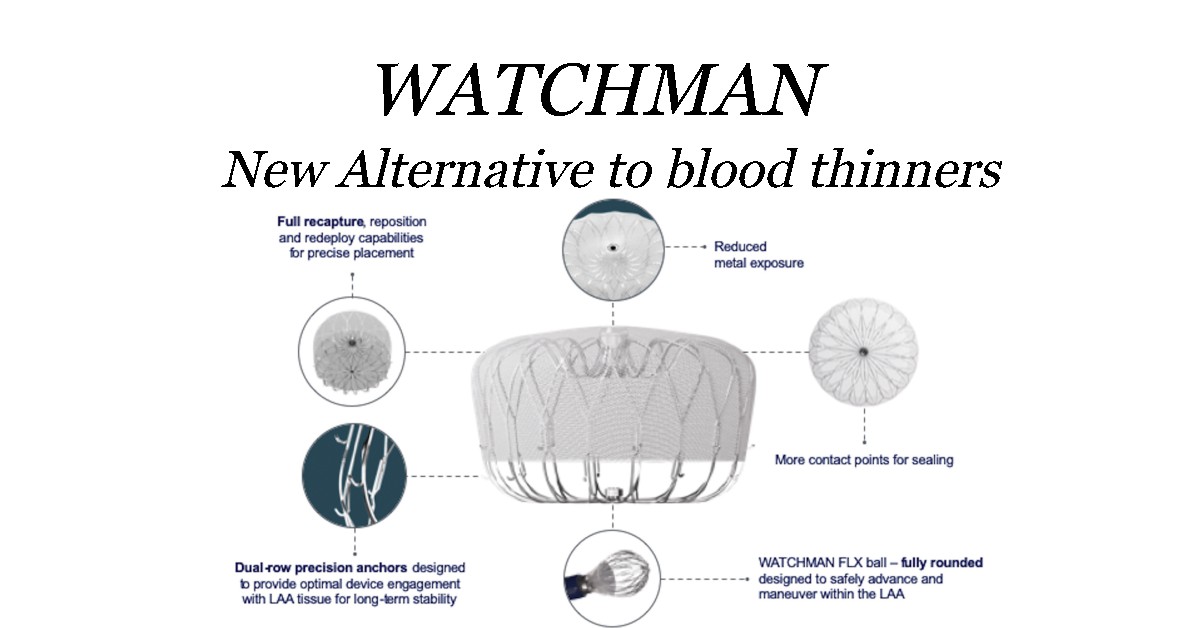What is a watchman implant procedure?
Watchman implant is a current technology that offers an alternative to blood thinners. The watchman implant procedure involves implanting a device in the heart to treat non-valvara trial fibrillation (a-fib). The procedure involves placing the watchman device on the left atrial appendage (LAA)at the upper part of the heart. Having a watchman implant protects atrial fibrillation patients from suffering from a stroke while not using blood thinners.
Atrial fibrillation experiences irregular heartbeats, resulting in slower blood flow in the heart chambers. The irregular heartbeats increase the risk of patients developing blood clots at the LAA. The clots can move from the LAA and join the bloodstream as the heart continues to pump the blood. Patients will likely suffer a stroke if the clot blocks blood flow into the brain.
Healthcare givers prescribe blood thinners such as warfarin to minimize the risk of clot formation among atrial fibrillation patients. Blood thinners have numerous side effects like bleeding, which can cause significant negative implications on the patient body. Atrial fibrillation patients constantly worry about the chances of developing a stroke and blood thinner side effects. The constant worries developed the need for a more stable solution for atrial fibrillation patients.
The Food and Drug Administration consented to the watchman implant procedure to treatatrial fibrillation patients. The watchman implant is a parachute-shaped device with a membrane to filter clots from leaving the LAA. Once implanted, the device expands to fit the size of a heart quarter. The device fits in the hearts of many needy patients. The watchman implant procedure provides a permanent solution to health concerns associated with clot formation.
Watchman vs blood thinner
Blood-thinning anticoagulants have been popular among patients at a high risk of blood clots. The FDA approved a variety of blood thinners that atrial fibrillation patients can use to minimize the risk of stroke. Warfarin has dominated the market since it uses Vitamin K elements to block the formation of blood clots. Other approved blood thinners for the same purpose include dabigatran, rivaroxaban, apixaban, and edoxaban. Experts in the medical field managed to identify fixed dosages for atrial fibrillation to minimize frequent blood tests.
Patients taking blood thinner constantly worry about side effects threatening their well-being. The most popular side effect associated with blood thinners is bleeding. In most cases, the bleeding is minor such as gum and nose bleeding. Patients on blood thinners are also likely to lose a lot of blood if cut due to the slow formation of clots. Blood thinner bruising under the skin is common among patients taking warfarin.
Watchman implant procedures and blood thinners offer some relief to atrial fibrillation against the fear of stroke. However, patients on blood thinners have to worry about blood thinner bruising if prescribed a fixed dosage. The watchman implant device helps address the fear of the health implications arising from blood thinners. Atrial fibrillation using the watchman implant procedure will not have to worry about blood thinner bruising.
Watchman implant procedure
The watchman implant procedure is appropriate for atrial fibrillation seeking a safe alternative to blood thinners. Besides safety, atrial fibrillation patients consider an alternative with a comparable stroke reduction. The insertion of the watchman implant involves a one-time procedure. The watchman implant device is permanent and does not raise a need for replacement. The watchman implant device cannot be seen from the outside since it is inserted in the internal part of the body.
In this video (https://youtu.be/cyT0kO-WE6U), cardiologists in South Denver explain the procedure involved in inserting the watchman implant. The procedure begins with administering anesthesia through an intravenous (IV) process. At this point, the nurses administer any other medication the patient needs for a successful procedure. It is important to note that the procedure is mainly non-invasive. The next step is where the cardiologist cuts a small area on the upper leg, preferably on the groin. The doctors use the opening to enter a catheter-directed into a blood vessel.
The next step is where the cardiologist guides the catheter into the heart and ensures it accesses the upper right chamber. The doctors then move the catheter to the muscular wall separating the left and right chambers in the upper heart. It is at this point that the doctors locate the LAA opening. The procedure is only effective if the watchman device is in the right place. Cardiologists use transesophageal echocardiography imaging tests before implanting the watchman device to enhance accuracy. Upon verifying that the catheter is in the correct position, the cardiologist pushes the watchman device out. The device opens up like a parachute as soon as the doctor pushes it out of the catheter.
The surgery is not long since it lasts for at least 30 minutes. Patients stay in the hospital for one night as the doctors continue to observe their responses. In some incidents, the doctors conduct another transesophageal echocardiography imaging test within 48 hours. Non-valvar atrial fibrillation patients continue with their blood-thinning medication for 45 days after the implantation of a watchman device. During this period, tissues will grow and engulf the watchman implant. At least 96% of atrial fibrillation patients that have undergone the procedure stopped their blood thinning medication within 45 days. However, patients must constantly consult their doctors before stopping their blood-thinning medicines.
Patients should expect to deal with a blood thinner bruising where the doctor inserts the catheter. It is essential to note that a certified cardiac electrophysiologist should only conduct a watchman implant procedure. The cardiac electrophysiologist has immense knowledge in treating heartbeat issues like atrial fibrillation. The heart disease experts work in a close relationship with cardiologists. Having the right expert perform the procedure minimizes the risk of any impending complications.
Benefits of the watchman implant procedure
The watchman implant procedure is an important treatment method for non-valvar atrial fibrillation patients because it inhibits stroke attacks. Watchman device implant is effective in preventing clot formation in the LAA. Unlike blood thinner prescription, the watchman implant procedure involves a one-time medical process. If done right by an expert, the chances of developing complications are low. If the procedure is done correctly and on time, atrial fibrillation patient does not have to worry about the side effects.
Another benefit of the watchman implant procedure is that it is less invasive. The patient does not have to undergo a high-risk operation to insert the watchman device at the LAA opening. The procedure occurs only briefly, and patients experience no pain since it is done under general anesthesia. Similarly, the recovery process is easy since the patient is only held in the hospital overnight. Surgical operations involving the heart are delicate. However, it is unlike the case with the watchman implant procedure that does not involve open surgery.
Most people can embark on daily activities a week after the watchman implant procedure. Patients should consult their doctors about their readiness to return to work to avoid preventable complications. Experts recommend adequate rest to ease the recovery process for atrial fibrillation, having undergone the watchman implant procedure. Enough rest will minimize the chances of over bleeding or blood thinner bruising since the patients continue with their medication temporarily.
Risks of the watchman implant procedure
Like any other medical procedure, inserting a watchman implant device has some associated risks. Patients should extensively discuss the procedure with their providers to fully understand the possible implications. The use of general anesthesia has some effects, such as nausea, confusion, and allergy reactions. Patients undergoing the watchman implant procedure will likely develop side effects since the procedure happens under general anesthesia.
Other possible risks include accidental heart puncture, which is life-threatening. The procedure ought to be handled with care to avoid such an occurrence. Due to the entourage of a catheter through blood vessels, there is a risk of air embolism. The air bubbles inhibit adequate blood supply through the blood vessels and can lead to death if not corrected. Another implication is blood thinner bruising at the point where the catheter penetrated the body. Patients with already thin blood might experience heavy bleeding following the watchman implant procedure. Due to the procedure’s proximity to the groin, there is a risk of fistula. Other infections that patients might develop include renal failure, pulmonary vein obstruction, pneumonia, thrombosis, hypotension, stroke, and death.
Patients undergoing the watchman implant procedure can help minimize the above risks. The patient should give an accurate and detailed account of their medical history. It helps determine whether one has any allergies and forecast likely reactions to the medication used. Health experts encourage patients that undergo the watchman implant procedure to lie down for long hours after the insertion. Enough effort should be made to research the health expert conducting the procedure and assess their experience. The patient should cooperate with the doctors by informing them about emerging concerns. Such cooperation makes achieving patient satisfaction and best medical results possible since it becomes possible to handle all emerging implications on time.
Independent test of some products
I also run some tests to see how food affects our blood condition. If you are interested see it you can watch it on Hematic Food youtube channel. Here is on of the examples.



